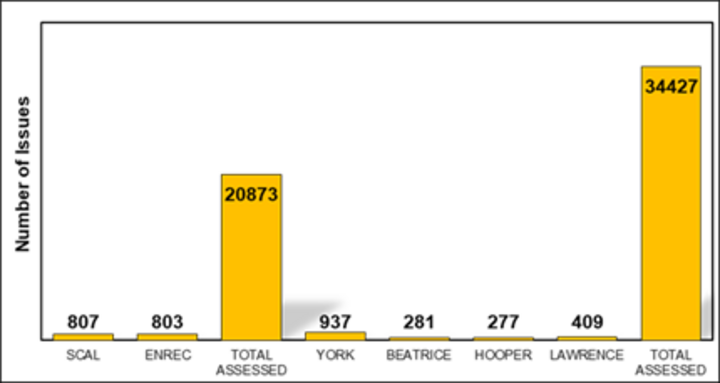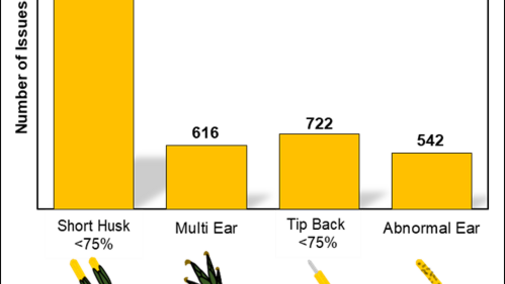You would think that more than 70 years after our predecessors had a basic understanding of corn development that we would understand it completely. Not true! The ear issues that affronted us in 2016 still plague some farmers, reducing productivity and causing us, as researchers, to continue to ponder possible causes.
Project Background

In July 2016, ear formation issues were reported in several corn fields ranging from the Texas Panhandle to eastern Colorado and through Nebraska, Iowa, and Illinois. Nebraska’s reports ranged from Dawson to Saunders counties and south to Kansas with numerous reports in Clay and Thayer counties. A CropWatch article was released to raise awareness of these issues (Elmore et al., 2016). In 2017, a follow up article was released in the Crop Production Clinic Proceedings (McMechan et al., 2017). The current report summarizes what we’ve learned to date.
Ear Issues and Field Surveys in 2016-2017
In an effort to better understand the causal agents of those issues, approximately 1,600 samples of affected and non-affected plants were collected from 16 farmers’ fields in central and eastern Nebraska during the 2016 and 2017 growing seasons. We are considering four main hypotheses as possible explanations for these issues:
- Loss of the primary ear, followed by abnormal secondary ear development.
- High ethylene concentrations, a natural plant hormone that is not harmful in normal levels.
- Leaf collar constriction, which could restrict ear formation.
- Internode length, as a possible way to diagnose some of those issues.
Ear symptoms reported and under evaluation are (Figure 1):
- normal secondary ears;
- short husks, normal ear
length; - barbell ears, three classes; and
- multiple ears per node.
Findings from 2016-2017
- Internode length appeared to be different among ear with different symptoms
- Plants with ear issues had a lower ear height and were placed on lower nodes.
- Maximum grain weight was achieved with normal ears while all plants with ear issues had drastically reduced yield.
- A regional analysis is underway as a follow-up to the field survey.
Ear Issues and Experimental Fields In 2018

A relatively low level of ear issues were observed in 2018. No major influence of planting dates was found; however, hybrids and seeding rates seemed to have an impact. Susceptible (race-horse) hybrids and high seeding rates consistently resulted in a greater number of issues.
In 2018, after the 2016/2017 learning experiences, a layout of experiments was established. This year, the main research questions concerned:
- Primary ear loss
- Ethylene concentration
- Sheath constriction
- Internode length
- Hybrid specific
- Heat, drought, and wind stress
- Seeding rates
- Planting dates
- Delayed emergence
- Ear placement and height
To better understand these research questions, seven experimental fields (Figure 2) were established in the 2018 growing season in central and eastern Nebraska evaluating contrasting conditions of:
- Eight hybrids: four susceptible (race-horse) and four checks (work-horse).
- Four planting dates with about 12-day intervals from late April to late May.
- Five seeding rates: 18,000; 26,000; 34,000; 42,000; and 50,000 seeds per acre.
- Delayed emergence: six hourly-delayed planting treatments established with the intent to simulate delayed emergence. Treatments were zero (control), 6-, 12-, 24-, 48-, and 96-hour intervals.
From all studies, intensive plant information was collected at emergence, V4 (4th collared leaf), and V6 (6th collared leaf) vegetative stages. Later, at reproductive stage R5 (dented kernels), ear issue assessments in all plots and sites were completed (Figure 3). Plant samples of affected and non-affected ears were taken and are being analyzed.


Relatively low pressure of ear formation issues was documented in 2018. In total, about 55,300 plants and ears were individually assessed and from those, 3,514 had ear issues. To put this in perspective, ear issues represented about 7% out of the total assessed number of plants. Three of the six sites (SCAL, ENREC, and York) presented higher incidence of issues (807, 803, and 937 ear issues recorded, respectively). Ear assessment was not conducted in the 7th site due to high pest pressure and mechanical damage of plots.
The 7% (n=3,514) of ear issues observed (Figure 4) corresponded to:
- short husks (only when shortage exceeded 25%),
- multiple ears per node,
- tip backs (only when greater than 25%), and
- abnormal ears.
Short husks led the count with more than 2,000 recordings while the other three ear types were similar in that they had lower incidences. No major influence of planting dates was found. However, hybrids and seeding rates seemed to have an impact. Susceptible (race-horse) hybrids and high seeding rates consistently resulted in greater number of issues.
Findings 2018
- Variable ear height was observed between and within plots; plant samples were collected and will be analyzed.
- A low pressure (about 7%) of ear issues was recorded across sites, hybrids, plantings, and seeding rates.
- More issues were recorded under susceptible hybrids (race-horse) and high seeding rates (50,000 seeds per acre).
- Field samples and data are currently being processed.
Preliminary Overriding Conclusions, 2016-2018
Help us by reporting ear issues in your fields. Please contact one of the authors: |
|
| Roger Elmore Crop Systems Agronomist roger.elmore@unl.edu Phone: (402) 472-1451 |
Justin McMechan Crop Protection and Crop Systems Specialist justin.mcmechan@unl.edu Phone: (402) 624-8041 |
| Osler Ortez Ph.D. Student oortez2@unl.edu Phone: (785) 370-9369 |
Tom Hoegemeyer Professor of Practice thoegemeyer2@unl.edu Phone: (402) 472-2811 |
- The main observation that seems to cut across all these symptoms is the loss of the primary ear node followed by development of a secondary malformed ear.
- The issues all appear to be hybrid-specific. The hybrids affected reportedly are race-horse materials, which have offensive characteristics by nature.
- The widespread nature of the symptoms suggests a weather-related stress event interacting with genetics and management practices.
References
Elmore, Roger, Jenny Rees, Justin McMechan, Tamra Jackson-Ziems, and Tom Hoegemeyer. Corn Ear Formation Issues Likely Correlated With the Loss of the Primary Ear Node. CropWatch. University of Nebraska Extension, August 19, 2016.
McMechan, Justin, Roger Elmore, and Jenny Rees. 2017. Corn ear formation issues – 2016. In 2016 Crop Production Clinic Proceedings, pages 27-29, University of Nebraska Extension.

